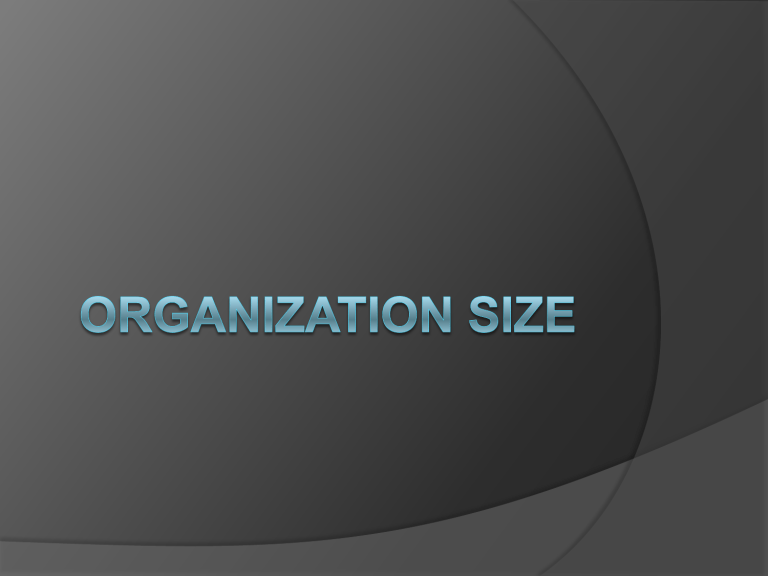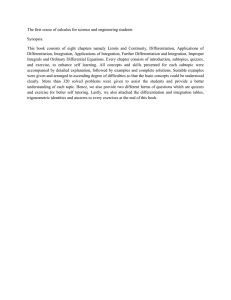
What is organization? Total number of employees - But there are some questions on its viability like: Full time or part time employee to be considered? What if business is seasonal? Optimum number e.g. 500 is large no. for a salon while same 500 is very small no. for steel manufacturing company. Advocates of Size Imperative Given by Peter Blau based on studies of govt. agencies, universities and department stores. He concluded “size is the most important condition affecting the structure of organization.” Increasing size promotes structural differentiation but at a decreasing rate. Another research done by Aston group concluded that “an increased scale of operation increases the frequency of recurrent events and the repetition of decisions” Meyer’s concluded that “one cannot underestimate the impact of size on other characteristics of organisation” Critics of the size imperative Size affects structure only in organizations that have professional managers not among those that are owner controlled. Argyris concluded that size is related to structure but u cannot say it causes it. Mayhew and his associates challenged blau’s finding on mathematical basis that relationship of size and complexity is relevant only till they were assigned equal probabilities to possible structural combinations. Aldrich reanalyzed the Aston data and proposed several alternative and equally plausible interpretation. Hall and his associates concluded from their study that neither complexity nor formalization can be implied from organizational size. Size and Complexity Impact of size on complexity was at a decreasing rate (Blau) Government organizations: where managers have greater discretion, structure causes size. Consequently, they may choose to make their structures more complex as more activities and personnel are added. There is also a possibility of circular sizestructure relationship Size generates differentiation and increasing differentiation also generates increasing size. When size increases there is more vertical differentiation, while larger the organization, more pronounced is the division of labour within it which is also true for functional differentiation. There is no evidence for size-spatial differentiation. Size and Formalization A recent comprehensive review of 27 studies covering more than 1000 organization concluded that relationship between size and formalization was high, positive and statistically significant. This can be concluded from given situations: As size increases direct supervision becomes difficult so efficient functioning through number of supervisors more of rules and regulation exerting controls are introduced. As organization become large the behavior repeat themselves and hence mgt is motivated to handle them more efficiently through standardization. It also depends on whether organization is independent or is subsidiary of a larger organisation. Size and Centralization It is obvious that it is not possible to control large organization from top. Thus we can say conclude that size leads to decentralization. But the counter argument to this is relationship between size and centralization is almost zero this may happen because in owner based firm owner are not ready to loose their control. How big is big? Small organization: 1500-2000 employees When organizations grow more that 2000 employees it becomes increasing difficult to coordinate without differentiating units, creating formalized rules and regulations or delegating decision making downwards. Some findings: 1. Adding employees to an organization once it has approximately 2000 members should have minimal impact on its structure 2. A change in size will have its greatest impact on structure when the organization is small. Administrative-Component Debate What is Administrative component? Ratio between managers and employees; The proportion of line managers and their support staff to operating or production personnel; Staff v/s line, with staff composing the administrative component All the personnel in an organization who engage in “support” activities. Using the last parameter – all the diff directly employees in staff or general administrative divisions are included Thus drivers, cafeteria employees, clerical help are included The Correlation Argument Positive relationship between organizational size and administrative component (Parkinson) As the size increases the administrative component increases disproportionately. Negative relationship argument: The proportion of the supporting personnel would decline as the size increases This assumption is based on the efficiencies from economies of scale. Moreover, owner-managed organizations and partnerships were less likely to add administrators as this would mean loosing personal power. The Correlation Argument The Curvilinear Argument: The administrative component is greater for smaller and larger organizations than for those of moderate size. As organizations move out of the small category, they enjoy the benefits from economies of scale. But as they become large, they lose these benefits and become so complex as to require significant increases in the administrative component to facilitate coordination and control Organization Theory and Small Business Is OT useful for small businesses? Issues of reduced importance: The range of variation in small businesses is limited so all the structural variables are of less importance They have minimal degree of horizontal, vertical, and spatial differentiation. Have low formalization and high centralization When specialized expertise is needed, it is purchased from outside. Eg. Accountant or a lawyer. Organization Theory and Small Business Vertical differentiation is low as the structure tend to be flat, spatial differentiation is low business small businesses don’t spread their activities widely. The control is achieved by holding on to the decision making machinery – centralized decision making. Less conflict as the small size facilitates communication, allows the members to have a clear sense of the organization’s mission and reduced the likelihood of goal incompability. Less of cultural problems as the cultures are young and less entrenched and when it is required, they can be changed. Organization Theory and Small Business Issues of reduced importance: Some issues of greater importance for small businesses include control and accountability, efficiency and environmental dependence Control: Small business managers are strong advocates of “management by walking around” So they are often willing to settle for lesser monetary reward in return for personal control and accountability. Resources: Efficiency is more important in small businesses due to slack resources Environment: Small business have less control on environmental factors such as suppliers, competitors and financial resources. – This increases the importance of environmental monitoring system which requires the right structure Conclusion Small businesses are different from their larger counterparts. They have different concerns and priorities. Also they have limited set of structural options.

